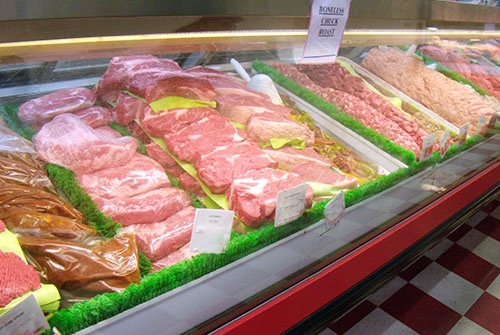Discover Fresh Cuts at Bagley Farms Meat Market Edwardsville IL for Your Following BBQ
Discover Fresh Cuts at Bagley Farms Meat Market Edwardsville IL for Your Following BBQ
Blog Article
Reveal the Art of the Butcher's Cut in a Modern Meat Market
In the ever-evolving landscape of modern-day meat markets, the butcher's cut has transcended its typical roots, combining old-time craftsmanship with modern practices. What genuinely establishes the modern butcher apart is their capability to forge a deeper link in between customers and the beginnings of their meat.
Evolution of Butchery Strategies

The mid-20th century saw butchery strategies additionally improved by scientific insights into muscular tissue biology and meat aging, enhancing both tenderness and taste. Technologies like vacuum cleaner packaging and refrigeration extended product shelf-life, enabling butchers to diversify offerings and boost quality assurance. This period also noted the increase of specialized tools, such as band saws and meat slicers, which enhanced accuracy and effectiveness in meat processing.
Computerized systems now assist in tracking animal provenance and maximizing cuts to meet certain customer preferences. Furthermore, a resurgence in artisanal butchery has arised, mixing traditional skills with modern-day knowledge to cater to consumers looking for moral and sustainable meat choices.

Understanding Meat Cuts

Recognizing the complexities of meat cuts is necessary for both butchers and consumers seeking top quality and value. For butchers, precise cuts show skill and regard for the craft, guaranteeing marginal waste and ideal return.
The main categories of meat cuts consist of primal, sub-primal, and retail cuts. Primitive cuts, such as the loin, rib, and chuck, are the large sections originally separated from the carcass. Butchers after that break these down better into sub-primal cuts, prior to finally creating retail cuts readily available to consumers, like ribeye or tenderloin. Each phase requires cautious focus to physiological structure and muscular tissue structure.
Comprehending muscular tissue composition is vital; muscles utilized a lot more regularly by the animal have a tendency to be harder and are best matched for slow-moving cooking techniques, while less-used muscular tissues, like those found in the loin, are more tender and perfect for grilling or roasting. Experience with these differences equips customers to make enlightened choices, enhancing their culinary ventures.
Selecting High Quality Meat
Choosing the appropriate meat includes more than simply choosing an aesthetically attractive piece from the display screen. The art of choosing quality meat calls for a discerning eye and expertise of certain characteristics that signify quality and excellence.
Second of all, straight from the source think about the marbling, which describes the white flecks of fat within the muscular tissue. Appropriate marbling is a key sign of tenderness and flavor, as it thaws during food preparation, improving the you could try here meat's juiciness. Remember, greater marbling typically correlates with exceptional top quality cuts, such as USDA Prime.
Structure is an additional vital element; meat must really feel solid to the touch, not slimed or excessively soft. Furthermore, bear in mind the scent. Fresh meat must have a clean, neutral smell, cost-free from any sour or repulsive smells.
Matching Cuts With Food Preparation Methods
Effectively coupling cuts of meat with the suitable cooking techniques is essential for accomplishing optimum taste and texture. Different cuts differ in inflammation, marbling, and connective cells content, each needing specific techniques to unlock their capacity. For example, tender cuts like filet mignon and ribeye, with their inherent marbling, take advantage of high-heat, quick-cooking techniques such as cooking or pan-searing. These techniques improve the meat's all-natural tastes and make sure a juicy coating.
Conversely, tougher cuts like brisket and chuck roast are rich in collagen, which damages down right into jelly when prepared slowly. These cuts are optimal for braising or slow-moving roasting, permitting the meat to soften gradually and establish deep, complicated flavors. Cuts such as short ribs and pork shoulder get on well with slow-cooking approaches, where expanded cooking times change their robust textures right into succulent recipes.
Lamb shanks and oxtail, which need extended cooking to soften, are best candidates for stewing or slow-moving simmering. These techniques coax out rich, passionate tastes while preserving moisture. By understanding the one-of-a-kind attributes of each cut, chefs and home cooks alike can raise their culinary creations, making sure each dish is both pleasing and unforgettable.
The Butcher's Duty Today
Navigating the advancing landscape of the contemporary meat market, the butcher's duty today prolongs beyond mere prep work of cuts. Contemporary butchers are culinary craftsmens, educators, and supporters for sustainable techniques. They bridge the void between the ranch and the fork by ensuring moral sourcing, understanding pet husbandry, and prioritizing openness in the supply chain. This change shows the expanding consumer need for high quality over amount, where provenance and animal well-being are critical.
Along with crafting precise cuts, butchers now engage straight with customers, providing cooking suggestions and tailoring choices to fit specific needs and preferences. Their competence in meat aging, marbling, and flavor accounts empowers consumers to make enlightened choices, enhancing their culinary experiences. This individualized solution exemplifies the butcher's evolving role as a relied on expert in the kitchen.
Furthermore, butchers are critical in minimizing waste, using Source entire animals to create diverse items such as sausages and supplies - bagley farms meat market edwardsville il. This comprehensive strategy not just appreciates the pet however also lines up with contemporary sustainability goals. This way, the modern butcher personifies both tradition and advancement, adjusting to an ever-changing market while protecting the creativity and stability of their craft

Conclusion
Mastery in recognizing varied meat cuts and quality signs equips butchers to provide informed suggestions, aligning specific cuts with ideal food preparation approaches. By honoring historical methods while embracing contemporary demands, the butcher's function stays essential in today's innovative meat market.
Report this page